Japanese Knife
Should I (left-handed) Buy Chef Knife for Left-Handed?
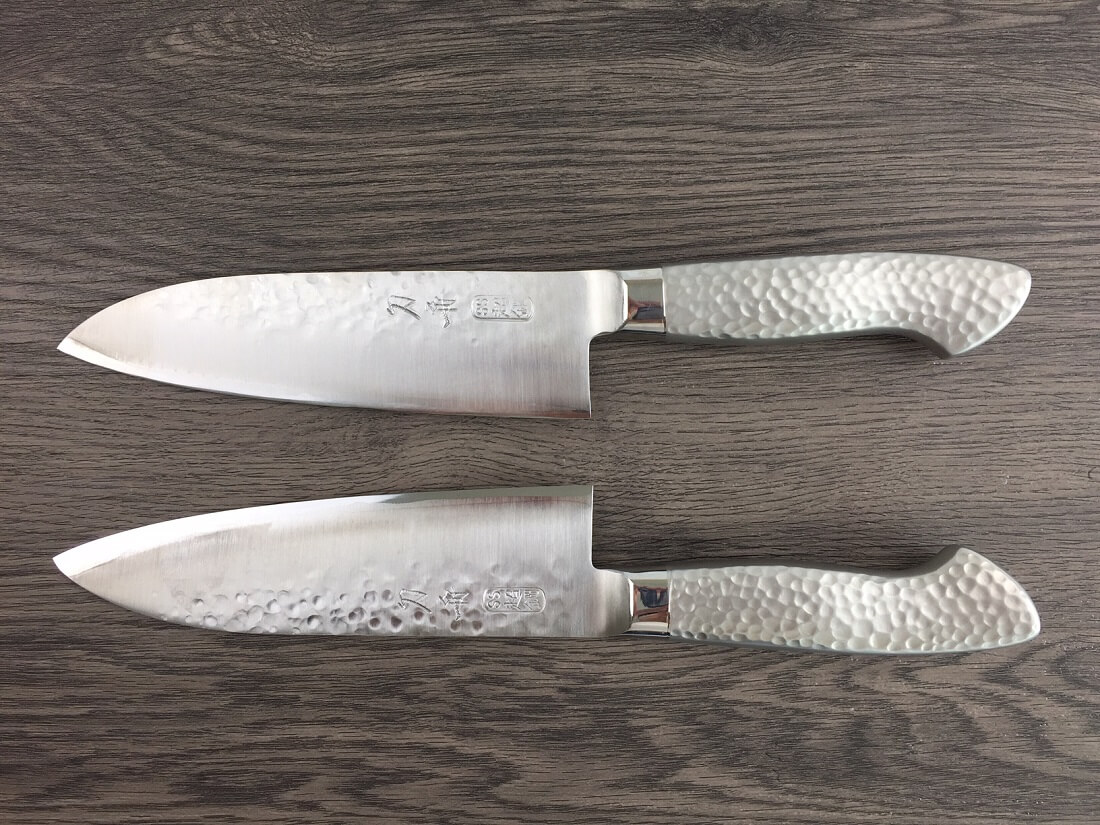
There is one thing I want you to know.
Almost all of product in the world is optimized to right-handed people. (at least it is in my country!) According to a research, 90% of population is right-handed regardless of race and nation.
In Japan, for example, all letters are easier to write for right-handed people. Japanese swords for samurai and their swordsman schools are structured in right-handed base. Furthermore, switches and buttons of electronic devices are easier to use for right-handed. Needless to say, Japanese chef knives are designed for right-handed.
Then, what left-handed should do? Does left-handed people should buy the chef knives made for right-handed?
In this post, I introduce the point left-handed people should care of when they buy Japanese chef knives. Also, I introduce structure of left-handed chef knives and their advantages.
The Case Left-handed People Should Be Care of
When right-handed people want to buy kitchen knives, there is nothing they should be care of. They can buy anything they want unless it says, “this product is for left-handed”. (We don’t see such “left-handed” product much in shops though..) This is because most of products are designed for right-handed.
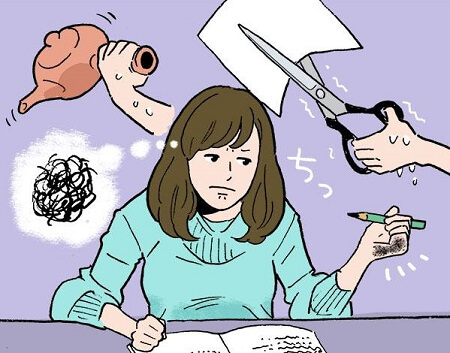
It’s not the case for left-handed people. There are a lot of left-handed people who don’t know chef knives have right-handed, left-handed and ambidexter products.
Having said that, many people don’t feel inconvenience for their kitchen knives. One reason for that is most kitchen knives can be used by both right-handed and left-handed. Ordinary shape multi-purpose knives or Santoku knives are in this kind.
Ambidexter knives are most popular product and sold anywhere because it doesn’t care about dominant hand, can be literally used for “multi-purpose”, and is easily used by from kids to seniors.
What are Ambidexter Knives
Ambidexter knives are “double-edged” knives. Multi-purpose knives (Santoku) or Chef’s knives (Gyuto) are double-edged knives, so they don’t care about users’ dominant hands.
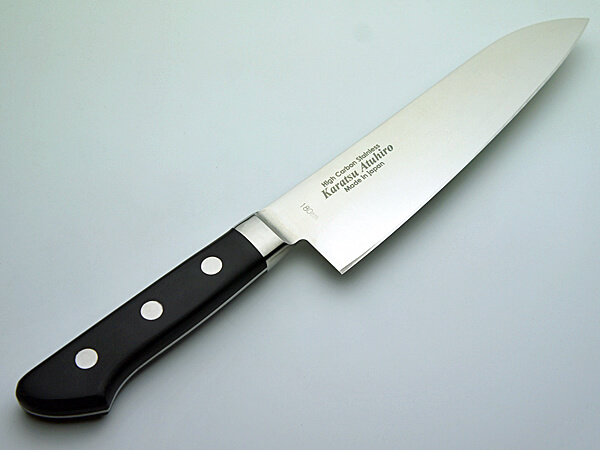
What is Double-edged?
Literally, double-edged knife has edges on both sides. Looking its blade from the top, both right and left sides are sharpened equally, therefore right-handed and left-handed people can use it completely equally.
What are Non-ambidexter Knives
All kinds of Japanese knives belong to them. They are “single-edge” knives. Single-edge knives are designed for right-handed people.
For example, the following Japanese chef knives are single-edged.
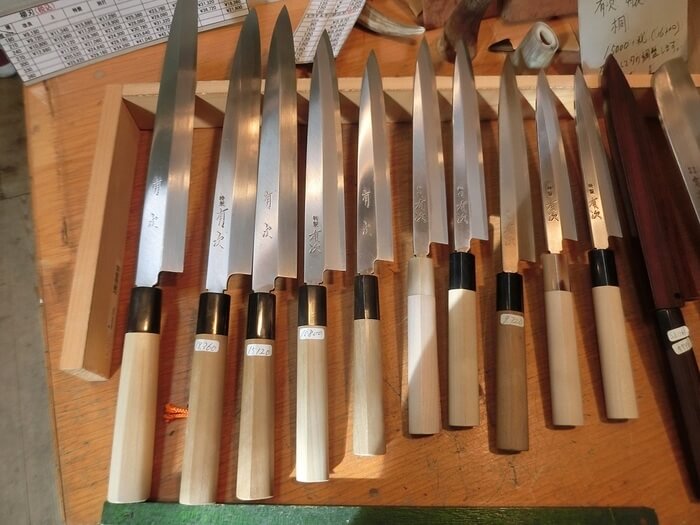
What is Single-edged?
Literally, single-edged knife has an edge in either side of the blade. Looking at cross-section, its edge shape is like obliquely cut and the shape is asymmetric.
These single-edged chef knives are popular among overseas customers because these tihn blades evoke traditional Japanese swords “Katana” for Samurai and Ninja. However, you have to be careful to shop this kind of knives because it’s basically for right-handed.
In addition, the “splitting” structure of blade prevents cut foods from sticking when using the knife. Splitting structure is to make a hollow along with the back side of blade, which is a special feature of single-edged traditional Japanese knives. (mass-made knives by machines may not have this structure) This structure is also designed based of right-handed people.
How Left-handed People Should Buy Japanese Chef Knives?
Single-edged traditional Japanese chef knives are basically made for right-handed people as described above.
So, how should left-handed people buy such knives?
You may think like, “having said so, I can probably use a right-handed knife somehow. I’ve used any tools (scissors etc.) even they’re for right-handed people.”
Is it true?
I would say “No”.
It may be true that you can cut things by right-handed knives somehow. But it’s clearly hard-to-use and unable to draw out full performance of the knife. I’ll explain why with the figures below. Let’s take a look at the case you fillet a fish.
Fig case-1. Fillet a fish by right hand with a right-handed single-edged knife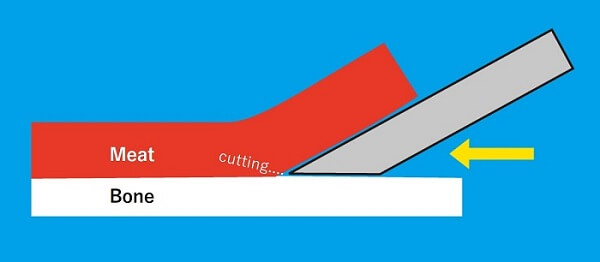
Grab a knife in accordance with its edge angle, cut a fish meat towards left side of the figure. You can cut like slicing off the meat from bones. This is the case right-handed people cut with ordinal right-handed knife.
How about in case using the same knife with left-hand?
Fig case-2. Fillet a fish by left hand with a right-handed single-edged knife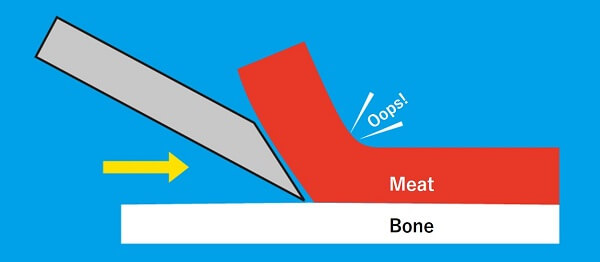
Oops! Fish meat is hard to be sliced off the bones because edge angle is too steep. This way, fish meat is easily going to be crumbled.
Then, what will be changed if left-handed people use a “left-handed” single-edged Japanese chef knife? Let’s take a look.
Fig case-3. Fillet a fish by left hand with a left-handed single-edged knife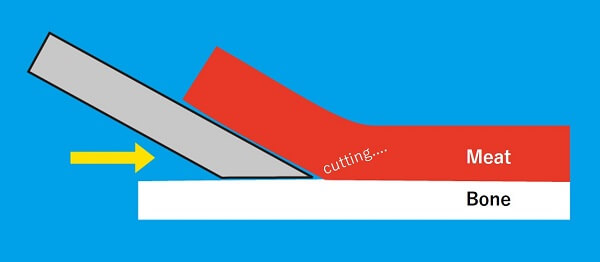
Yes!
Its edge angle is appropriately sharp and you’ll be able to fillet smoothly. Thus, left-handed people should use left-handed knives.
By the way, I want to add one more note. You may watch YouTube videos about how to fillet a fish with knives or how to use single-edged knives. In such cases, please note that they are mostly right-handed! (approximately 90% of population in the world is right-handed)
So, if you want to do the same thing introduced in the movies, you have to move knives in opposite direction when you use single-edged Japanese knives. Also, you have to turn over fish or cutting object.
Therefore, makers have left-handed single-edged knives in their lineup.
They make horizontally symmetrical knives as a “left-handed” knives. Edge angles, splitting structures and handles are symmetrical compared with right-handed knives.

Then, you may think it’s better to choose both-sided knives! It’s simpler and I don’t have to think about “hey, which handed knife is this?” and so on…
Well, it’s because single-edged knives have good advantages to thing about. Next, let’s take a look to advantages of single-edged knives.
Until today, many people pursue mysterious charms of the Damascus all over the world. Here’s an example of such guys.
What’s Good For Single-edged Knives?
First of all, a center of balance is different between single-edged and double-edged blades.
Symmetrical shaped double-edged knife has a center of balance at the center of the blade, so you can cut foods vertically. On the other hand, you cannot cut foods vertically with single-edged knife because its center of balance is out of center of the blade. The horizontal force toward edge side is there when you cut.
Because of this horizontal force, you can fillet a fish better with single-edged knife. As you saw on the figures above, single-edged Japanese knives are very good at filleting fish and doing decoration cut of vegetables.
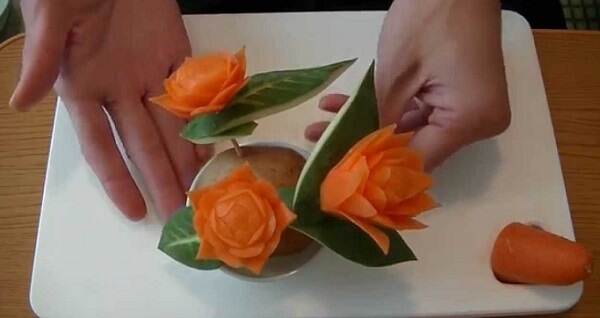
In addition, single-edged knives have an advantage when sharpening.
Although you have to sharpen both side of the double-edged blade, only one side is okay for single-edged knives. Furthermore, single-edged blade can be sharper because of its structure, therefore cutting performance can be higher than double-edged knives.
In Conclusion: What Left-handed People Should Know
Summary:
- Western knives or double-edged knives such as Santoku or Gyuto can be used equally by right-handed or left-handed people.
- Single-edged Japanese chef knives have left-handed products in addition to regular right-handed products. You should choose one suits your dominant hand, otherwise you cannot cut well.
- Because there are pros and cons for double-edged knives as well as single-edged knives, it’s not always true that you should choose double-edged knife due to its ambidexterity.
- Single-edged knives have good advantages you should know.
Finally, I’ll summarize pros and cons of double-edged knives and single-edged knives.
Double-edged Knives
Pros:
- You can easily cut foods vertically, so it’s easier to use for everyone, from kids to seniors.
- Both right-handed and left-handed people can use same knife
- It’s most popular products among the world, so you can find anywhere
- It’s generally multi-purpose and can be used in most of situations
Cons:
- Not very good at thin slicing due to its structure of the blade
- Cut foods tend to stick on the blade
- You have to sharpen equally on both sides of the blade, which is more difficult than sharpening single-edged blade
Single-edged Knives
Pros:
- Very good at thin slicing thanks to its sharper blade
- It’s very good at peeling fruits and do decoration cuts.
- It’s very good at filleting fish, especially slicing meet from bones and removing skins
- Faster and easier for sharpening
Cons:
- You cannot move blade vertically because of uncentered balance of the blade
- You may have to handle its sharper blade more carefully, or you can easily cut your fingers
Because of its specialties, single-edged chef knives are more for professional chefs or those who are good at handling knives. In fact, professional chefs mostly use single-edged chef knives.
When you become used to use kitchen knives and feel like you need more specialized knives, you should think about single-edged chef knives, then you may be able to cut better!
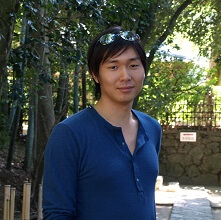
Author - Hiro
Lived in Kyoto in school days, I was impressed by profundity of history and tradition of the city. Had a job to join the three major festivals of Kyoto: Aoi, Jidai and Gion festivals. Love Kyoto and Japanese culture.
Manager of OrientalSouls.com, selling items of Japanese culture, tradition and craftsmanship. I'll introduce interesting information about Japan!

About Orientalsouls.com
Learn and Buy Japanese Craftsmanship, Tradition & Culture
OrientalSoul.com is the online shop where you can buy traditional crafts of Japan.
We only sell selected authentic products in which true spirits of Japanese craftsmanship exist.
You may be able to find similar products in other shops for lower prices. However, we sell products based on fair prices that worth labor and value of experienced craftsmen.
In addition, we introduce stories about product history, how a product is made, what makes it different from others, and how the product enriches your life!